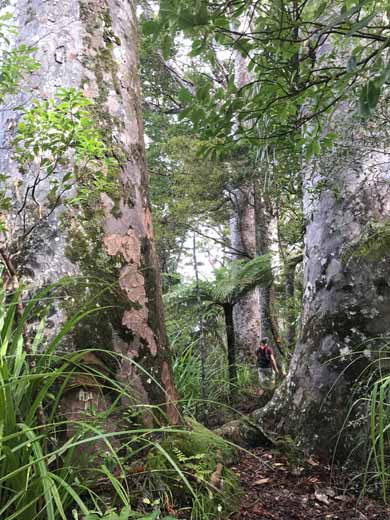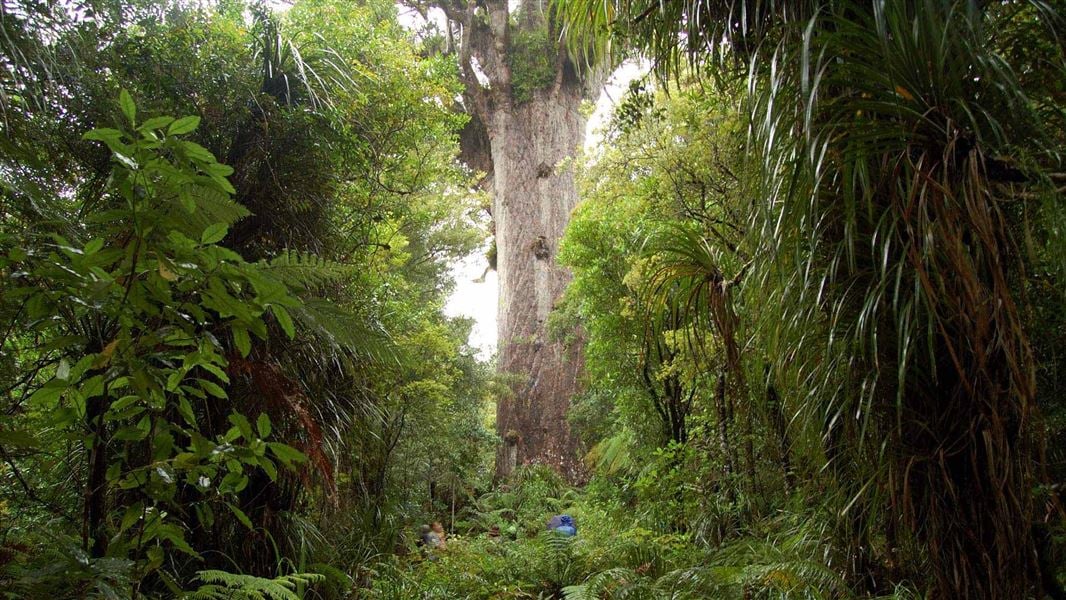Kauri forests once covered 1.2 million ha from the Far North of Northland to Te Kauri, near Kawhia and were common when the first people arrived around 1,000 years ago.
Image gallery
Past uses of kauri
Maori used kauri timber for boat building, carving and building houses. The gum was used as a fire starter and for chewing (after it had been soaked in water and mixed with the milk of the puha plant).
The arrival of European settlers in the 1700s to 1800s saw the decimation of these magnificent forests. Sailors quickly realised the trunks of young kauri were ideal for ships' masts and spars, and the settlers who followed felled the mature trees to yielded huge quantities of sawn timber of unsurpassed quality for building.
The gum too, became essential in the manufacture of varnishes and other resin-based products. The gum was obtained through digging, fossicking in treetops, or more drastically, by bleeding live trees.
More forest was cleared as demand for farmland and timber increased in the early and mid 20th century.
Kauri forests

Kauri in Waima Forest
Image: Sarah Wilcox | Creative Commons
Adolescent trees have straight pole trunks and a distinctive narrow conical crown. As the trees mature the trunk thickens and the lower branches are shed, resulting in the clean, straight trunk of the adult kauri.
Kauri forests are home to many other trees and plants including taraire, kohekohe, towai, Kirk’s pine, toatoa, tanekaha and rata, and a diverse understory of shrubs and other plants. In fact, because kauri live so long and their leaves are high in tannins, they modify the soil they live on, and create specialised habitats such as gumlands.
Saved from destruction
The Waipoua forests of Northland were at first saved from destruction by their remoteness. The land was purchased by the Crown in 1876, but for decades there was debate over what should be done with the forest. Public pressure for total protection increased after the turn of the century, although in the 1940s kauri was logged for wartime boat building supplies.
In 1952 the 9,105 hectare Waipoua Sanctuary was finally declared, with all remaining kauri forests in Crown lands coming under the protection of the Department of Conservation by 1987. Kauri trees on private land are now also largely protected.
Creating secure environments
Waipoua is home to Tane Mahuta, king of the forest and the largest remaining kauri tree in the country. The 1,500 year old Tane Mahuta is 51.5 m tall, with a girth of 13.77 m.
The forests of Waipoua are vitally important refuges for threatened wildlife. The endangered North Island kokako and the North Island brown kiwi both live here. More abundant are the kukupa/kereru (New Zealand wood pigeon), fantail, pied tit, tui, grey warbler, shining cuckoo and kingfisher. Another distinctive creature is the large and very handsome kauri snail, a carnivore which feeds mainly on earthworms, slugs and soft-bodied insects.
A lasting reminder of the once-thriving kauri industry are the kauri dams. Kauri driving dams were built by loggers to drive large quantities of kauri logs downstream from remote areas. While they played a major role in the destruction of the forest, they were also impressive engineering feats, built without drawings or detailed calculations, yet able to withstand the pressure of tonnes of water and kauri logs which were swept through with tremendous force when the dam was tripped.
In the Kauaeranga Valley on the Coromandel, kauri was logged extensively for over 50 years with more than 60 dams built. In 1970 remaining areas of surviving forest were deemed protected as part of the Coromandel Forest Park.
The Kaiaraara Dam on Great Barrier Island (40 m wide and 14 m high) is one of the largest of 3,000 kauri dams built in New Zealand in the 19th and 20th centuries.
Places you can see kauri
- Tane Mahuta Walk
- Te Matua Ngahere Walk
- Waiau falls and kauri grove lookout track
- Square kauri walk
- Cookson Kauri Walk
- Kauri block track
PA or kauri dieback disease – a threat to kauri
Phytophthora agathidicida (PA) is a soil-borne pathogen that infects kauri trees through their roots. PA restricts the ability of kauri to transport water and nutrients between their roots and their leaves, causing the condition known as kauri dieback disease, which eventually starves and kills the tree.
PA could have devastating effects on New Zealand’s kauri forests. It has been found in Northland, Great Barrier Island and the Coromandel Peninsula.
There is no known cure, but we can help reduce its spread by avoiding any movement of soil around the roots of trees. That means making sure we stick to the tracks and have spotlessly clean footwear and any gear that might touch the ground.
Get more information PA or kauri dieback disease
If you think you have seen symptoms of kauri dieback disease on public conservation land, contact the local DOC office.
How you can protect kauri
PA is easily spread through soil movements, for example, when soil is carried on dirty footwear, animals, equipment and vehicles.
Follow these steps to contain the disease:
- Use the wash station if available
- Clean your gear
- Follow the instructions on the signage
- Stay on the tracks
More information on Tiakina Kauri website
Follow guidelines tailored to your recreation activity to help save kauri: Activity guidelines on Tiakina Kauri website
If you think you have seen symptoms of kauri dieback disease on public conservation land, contact the local DOC office.
